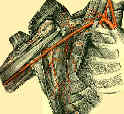- See: Arteries of the Upper Limb
- Discussion:
- the axillary artery begins at the first rib as a direct continuation of the subclavian artery and becomes the brachial artery at the lower border of the teres major
- artery passes behind pectoralis minor in its course thru axilla & is conveniently described as having 3 parts;
- 1st part is above muscle, 2nd under muscle, & 3rd below muscle;
- artery is paralleled by the axillary vein;
- medial cord of brachial plexus & its branches lie in part between the artery and vein;
- 1st part of artery lies on upper part of serratus anterior , w/ medial cord behind it & lateral & posterior cord lateral to and above it;
- 2nd & 3rd parts of arteries lie on subscapularis & teres major muscles, with the 3 cords of the brachial plexus;
- axillary artery usually gives off 6 Branches (from 5 to 11)
- supreme thoracic
- thoracoacromial artery
- lateral thoracic
- subscapular
- anterior humeral circumflex artery
- posterior humeral circumflex
- brachial artery: axillary artery leaves axilla at lower border of teres major to enter the arm as brachial artery ;
- 1st major branch is profunda brachi (deep brachii);
- it gives off muscular branches, usually gives rise to nutrient artery that enters humerus close to insertion of coracobrachialis
- superior ulnar collateral artery;
- arises from about the middle of the arm and passes posteriorly along the medial side of the arm w/ Ulnar nerve ;
- this artery runs w/ nerve behind medial epicondyle & anastomoses w/ recurrent branch from forearm;
- inferior ulnar collateral artery:
- arises only a little above the elbow;
- anastomoses w/ superior ulnar colateral & other vessels above elbow & w/ recurrent branch ascending from the forearm;
- Injury to Axillary Artery:
- injury to axillary vessels is more common than subclavian artery injury and more frequently seen from penetrating trauma;
- axillary artery is the continuation of the subclavian Artery from lateral border of the first rib to the lateral border of the teres major muscle;
- dx of axillary artery injury is based on clinical signs and symptoms, but definite signs of injury except for a bruit may be present in only two-thirds of the cases;
- this is accounted for by rich collateral network around shoulder;
- if none of classical signs is present but there is still suspicion of a vascular injury, arteriogram is indicated;
- w/ percutaneous axillary arterograms, note the uncommon occurance of hematomas that may compress the brachial plexus;
- this may result from a delayed pseudoaneurysm
- because of extensive collateral circulation that exits between thyrocervical trunk of the subclavian artery & subscapular artery, which is
branch of distal axillary artery, ligation or thrombosis of axillary artery usually will not lead to compromise of flow to distal arm;
- Axillary Artery Injury following Shouler Dislocation:
- blunt trauma to shoulder may produce injuries to axillary artery, such as from direct blow to the shoulder girdle;
- anterior dislocation of the shoulder, may stretch the axillary artery;
- anterior shoulder dislocation, reduction of a shoulder dislocation, or frx of neck of humerus can cause axillary artery rupture and subsequent thrombosis;
- forceful closed reduction of long-standing anterior shoulder dislocation, esp in elderly patient, should not be performed because of danger of axillary-artery rupture;
- injury is increased in patients w/ atherosclerotic disease;
- Thrombosis from Crutches:
- may aris from improper use of crutches resulting in axillary artery aneurysms;
- these pts may present w/ ischemic fingers & occulsion of radial and ulnar artery secondary to embolization from the aneurysms
Subclavian-axillary vascular trauma.
Arterial abnormalities of the shoulder in athletes.
Illustrated Encyclopedia of Human Anatomic Variation: Axillary Artery



